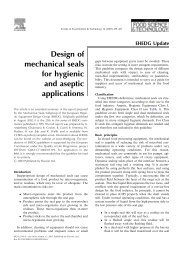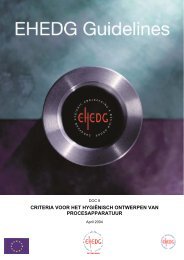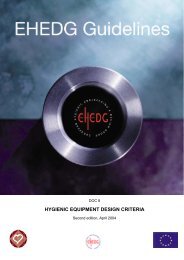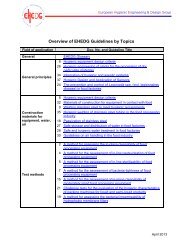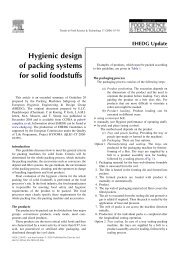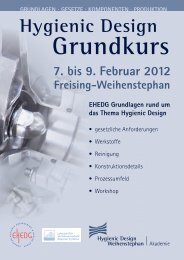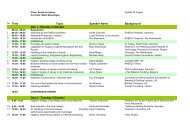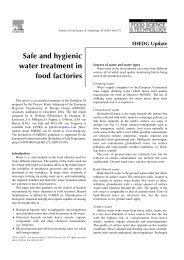Yearbook 2013/2014 - ehedg
Yearbook 2013/2014 - ehedg
Yearbook 2013/2014 - ehedg
Create successful ePaper yourself
Turn your PDF publications into a flip-book with our unique Google optimized e-Paper software.
European Hygienic Engineering & Design Group<br />
Optimisation of tank cleaning<br />
Using hygienic sensors to monitor tank cleaning<br />
René Elgaard, Managing Director, Alfa Laval Tank Equipment A/S<br />
e-mail: rene.elgaard@alfalaval.com<br />
Tank cleaning is a time-honoured tradition essential<br />
for producing high-quality foodstuffs and beverages.<br />
Technological advances in tank cleaning have raised the<br />
standards for food and beverage processing dramatically;<br />
the most drastic changes have occurred within the last 50<br />
years. To ensure the highest standards of hygiene, more<br />
rigorous standards and tougher regulations are now in<br />
place, not only for the tank itself but also for tank cleaning<br />
equipment.<br />
The improvements in hygiene standards/guidelines are a<br />
direct result of equipment users’ demand, as well as support<br />
garnered through organisations such as the European<br />
Hygienic Engineering and Design Group (EHEDG), which<br />
share the common aim of promoting hygiene during<br />
food and beverage handling, processing and packaging.<br />
The guidelines put forth for hygienic design of food and<br />
beverage process equipment essentially put all equipment<br />
manufacturers on a level playing field by establishing<br />
minimum standards for equipment quality.<br />
With all equipment being equal, it stands to reason that<br />
proper control of the tank cleaning process is the primary way<br />
to differentiate equipment based upon the level of cleaning<br />
efficiency achieved. The objective: to get accurate, reliable<br />
and repeatable tank cleaning results after the completion of<br />
each production cycle, whether a continuous process or a<br />
batch process is used.<br />
There are several ways to achieve the desired tank cleaning<br />
results by controlling the tank cleaning process. However, it<br />
is important to understand the process of tank cleaning, the<br />
various tank cleaning methods and the product contained<br />
in the tank before determining the best method of control to<br />
achieve optimal cleaning efficiency.<br />
Traditional tank cleaning<br />
There are various parameters that contribute to effective<br />
tank cleaning. These are perhaps best described by the<br />
“Sinner Circle,” which was developed by the chemical<br />
engineer Herbert Sinner to illustrate how to obtain good<br />
cleaning results. 1 Sinner defined four critical parameters that<br />
may be combined in numerous ways and applied to virtually<br />
any cleaning task, whether in a pipe, on a floor or in a tank.<br />
The parameters are time, action (or flow of cleaning fluid),<br />
chemistry and temperature, or TACT for short (Fig. 1). All<br />
four parameters are important to secure optimal cleaning<br />
efficiency; however, how they are combined is decisive in<br />
achieving optimal cleaning efficiency.<br />
Figure 1. The Sinner Circle illustrating the cleaning parameters<br />
of TACT. Herbert Sinner defined four critical parameters – time,<br />
action (or flow of cleaning fluid), chemistry and temperature, or<br />
TACT for short – which are important to secure optimal cleaning<br />
efficiency.<br />
Applying effective chemicals or cleaning agents and optimum<br />
temperature to the surface to be cleaned weakens the<br />
bond between the soil and the surface to a point where the<br />
available force (or action) can remove the soil. 2 The unknown<br />
factor is the available force. Time, chemical concentration<br />
and temperature can be controlled.<br />
What is the available force, and how is it applied to the<br />
surface? This depends upon the method and technology<br />
used to distribute the cleaning media in the tank.<br />
One of the oldest methods of tank cleaning, the “fill, boil and<br />
dump” approach, is still used by many industries for various<br />
applications. This simple cleaning method involves filling the<br />
tank with water and chemicals and heating its contents to the<br />
required temperature. The mixture is kept in the tank for a<br />
sufficient amount of time in order to allow the chemicals and<br />
temperature to react with the soil. The tank is then emptied<br />
or its contents “dumped.” This is a very expensive and<br />
time-consuming cleaning method, and the amount of force<br />
applied is minimal.<br />
Tank cleaning<br />
Tank cleaning-in-place (tank CIP) is a commonly used<br />
cleaning method, which applies force to the tank surface<br />
for the removal of soil without having to open and enter the<br />
tank. There are three different types of technologies used for<br />
cleaning the tank interior:<br />
1. Static spray ball (static cleaning device)<br />
2. Rotary spray head (dynamic cleaning device)<br />
3. Rotary jet head (dynamic cleaning device)



